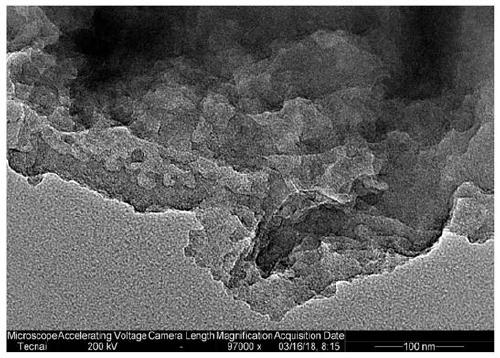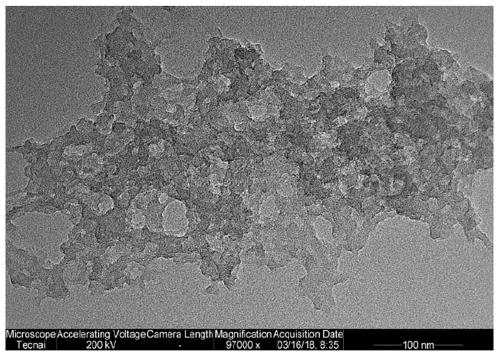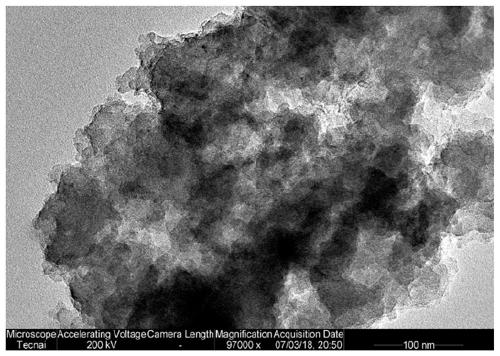Monodisperse porous organic metal polymer material as well as preparation method and application thereof
A polymer material and organometallic technology, applied in the preparation of organic compounds, organic compound/hydride/coordination complex catalysts, organic chemistry, etc., can solve the problem of affecting the performance of catalytic materials, increasing the cost of catalysts, and poor recycling performance problems such as good industrial application prospects, good universality, high reactivity and stability
- Summary
- Abstract
- Description
- Claims
- Application Information
AI Technical Summary
Problems solved by technology
Method used
Image
Examples
Embodiment 1
[0040] Embodiment 1, the preparation of porous organometallic polymer material POMP 1a:
[0041]
[0042] Add 1mmol of bisbenzimidazole nitrogen heterocyclic carbene iridium compound (0.63g) into a 50mL Schlenk tube, vacuum and change nitrogen three times, then add 10mL of 1,2-dichloroethane and 3mmol of benzene (0.23g) successively, and stir at room temperature After a period of time until the solids were completely dissolved, 9 mmol of dimethylformal (FDA, 0.68 g) and anhydrous ferric chloride (1.46 g) were added. After sealing, put the reaction system into an oil bath at 30-80 degrees to react for 1-72 hours. After the reaction was complete, it was cooled to room temperature, filtered, washed, and the obtained solid was extracted by Soxhlet for 24 hours, and vacuum-dried at 60° C. for 24 hours to obtain the porous organometallic polymer POMP1a. The TEM spectrum of the solid is attached figure 1 shown. Yield: 0.58 g, 60%.
Embodiment 2
[0043] Embodiment 2, the preparation of porous organometallic polymer material POMP 1b:
[0044]
[0045] Add 1mmol of bisbenzimidazole nitrogen heterocyclic carbene iridium compound (0.63g) into a 50mL Schlenk tube, vacuum and change nitrogen three times, then add 10mL of 1,2-dichloroethane and 3mmol of benzene (0.23g) successively, and stir at room temperature After a period of time until the solids were completely dissolved, another 12 mmol of dimethylformal (FDA, 0.91 g) and anhydrous ferric chloride (1.95 g) were added. After sealing, put the reaction system into an oil bath at 30-80 degrees to react for 1-72 hours. After the reaction was complete, it was cooled to room temperature, filtered, washed, and the obtained solid was extracted by Soxhlet for 24 hours, and vacuum-dried at 60° C. for 24 hours to obtain the porous organometallic polymer POMP1b. Yield: 0.70 g, 70%.
Embodiment 3
[0046] Embodiment 3, the preparation of porous organometallic polymer material POMP 1c:
[0047]
[0048] Add 1mmol of bisbenzimidazole nitrogen heterocyclic carbene iridium compound (0.63g) into a 50mL Schlenk tube, vacuum and change nitrogen three times, then add 10mL of 1,2-dichloroethane and 3mmol of benzene (0.23g) successively, and stir at room temperature After a period of time until the solids were completely dissolved, another 15 mmol of dimethylformal (FDA, 1.14 g) and anhydrous ferric chloride (2.43 g) were added. After sealing, put the reaction system into an oil bath at 30-80 degrees to react for 1-72 hours. After the reaction was complete, it was cooled to room temperature, filtered, washed, and the obtained solid was extracted by Soxhlet for 24 hours, and vacuum-dried at 60° C. for 24 hours to obtain the porous organometallic polymer POMP1c. Yield: 0.83 g, 80%.
PUM
 Login to View More
Login to View More Abstract
Description
Claims
Application Information
 Login to View More
Login to View More - R&D
- Intellectual Property
- Life Sciences
- Materials
- Tech Scout
- Unparalleled Data Quality
- Higher Quality Content
- 60% Fewer Hallucinations
Browse by: Latest US Patents, China's latest patents, Technical Efficacy Thesaurus, Application Domain, Technology Topic, Popular Technical Reports.
© 2025 PatSnap. All rights reserved.Legal|Privacy policy|Modern Slavery Act Transparency Statement|Sitemap|About US| Contact US: help@patsnap.com



